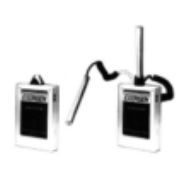
was not a lot different: large and expensive, requiring environmentally
controlled rooms, trained technicians, and exotic gases. Today’s ad-
vanced technology makes it possible to put the power of infrared ther-
mography in the palm of your hand, at a fraction of the cost of all previ-
ous techniques. While there are a variety of infrared thermometers avail-
able, only one is designed specifically to meet the stringent clinical re-
quirements, the DermaTemp Infrared Thermographic Scanner.
The DermaTemp Infrared Thermographic Scanner
The DermaTemp is a high precision hand-
held infrared thermographic scanner de-
signed to detect the subtle skin tempera-
ture variations caused by underlying per-
fusion variations. These instruments in-
stantly measure temperature on any sur-
face location on the human body without
the need for tissue contact.
The Dermatemp is highly recommended
for use in plastic and vascular
surgery,anesthesiology, pain manage-
ment, rheumatology, neurology, oncology,
and wound management. Other applica-
tions follow this section.
Infrared thermometry is fast, stable, repeatable, and is relatively insen-
sitive to user technique. Skin temperature measurements with infrared
thermometry are attractive because they are objective, low cost, and
cause absolutely no trauma or discomfort to the patient. The versatility
of the products allows for absolute temperature measurement, surface
scanning, and comparative methods of temperature differential.
Method Impedimenta
Despite the tremendous benefits of using infrared technology for clini-
cal applications, there are several impediments which should cause
pause, such as variable skin characteristics, wet skin, and environ-
mental influences. Since the process of measuring temperature by view-
ing the infrared radiation of the surface is significantly faster than the
other techniques mentioned earlier, the user needs to be aware of sev-
eral important considerations. The surface temperature of the human
body is sensitive to the external environment and can vary by several
degrees in a short period of time. Drafts will lower the surface tem-
perature. A cold room environment will lower the surface temperature.
Any surface moisture will lower the surface temperature. Exercise will
raise the surface temperature due to increased perfusion as a ther
DermaTemp DT 1001 and
DT 1001-RS
13


















